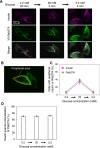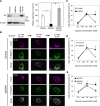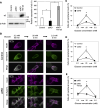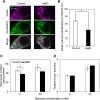The a subunit isoforms of V-ATPase are involved in glucose-dependent trafficking of insulin granules
- PMID: 40447629
- PMCID: PMC12125285
- DOI: 10.1038/s41598-025-02997-7
The a subunit isoforms of V-ATPase are involved in glucose-dependent trafficking of insulin granules
Abstract
In pancreatic β cells, insulin granules move toward the plasma membrane to secrete insulin upon glucose stimulation, but the amount of secreted insulin is only a small portion of the total, and many granules do not release insulin. Here, using MIN6 cells derived from mouse pancreatic β cells, we observed that granules that moved toward the plasma membrane returned to the inner area after the stimulation was removed. This back-and-forth trafficking is likely important for strict regulation of insulin secretion in response to the blood glucose level. However, the mechanism was largely unknown. We found that "back" (inward) and "forth" (outward) trafficking was reduced in cells with knockdown of the a2 and a3 subunit isoforms of the proton pump V-ATPase, respectively. Interestingly, the amount of secreted insulin was increased in a2 knockdown cells. Both a2 and a3 interacted with GDP-bound form Rab27A, a member of the Rab small GTPase family that regulates insulin secretion. These results indicate that a2 and a3 are involved in back-and-forth trafficking of insulin granules, respectively. The a subunit isoforms of V-ATPase seem to determine the direction of insulin granule trafficking dependent on the glucose level.
Keywords: Insulin secretion; Membrane trafficking; Rab27A; V-ATPase; a subunit isoforms.
© 2025. The Author(s).
Conflict of interest statement
Declarations. Competing interests: The authors declare no competing interests.
Figures








Similar articles
-
The a3 isoform of V-ATPase regulates insulin secretion from pancreatic beta-cells.J Cell Sci. 2006 Nov 1;119(Pt 21):4531-40. doi: 10.1242/jcs.03234. Epub 2006 Oct 17. J Cell Sci. 2006. PMID: 17046993
-
Exophilin8 transiently clusters insulin granules at the actin-rich cell cortex prior to exocytosis.Mol Biol Cell. 2011 May 15;22(10):1716-26. doi: 10.1091/mbc.E10-05-0404. Epub 2011 Mar 25. Mol Biol Cell. 2011. PMID: 21441305 Free PMC article.
-
Essential Role of the a3 Isoform of V-ATPase in Secretory Lysosome Trafficking via Rab7 Recruitment.Sci Rep. 2018 Apr 30;8(1):6701. doi: 10.1038/s41598-018-24918-7. Sci Rep. 2018. PMID: 29712939 Free PMC article.
-
V-ATPase a3 Subunit in Secretory Lysosome Trafficking in Osteoclasts.Biol Pharm Bull. 2022;45(10):1426-1431. doi: 10.1248/bpb.b22-00371. Biol Pharm Bull. 2022. PMID: 36184499 Review.
-
Vacuolar-type ATPase: A proton pump to lysosomal trafficking.Proc Jpn Acad Ser B Phys Biol Sci. 2019;95(6):261-277. doi: 10.2183/pjab.95.018. Proc Jpn Acad Ser B Phys Biol Sci. 2019. PMID: 31189779 Free PMC article. Review.
Cited by
-
SNX11 Deletion Inhibits Dabie bandavirus Infection by Interfering with the Assembly of V-ATPase.Pathogens. 2025 Jul 9;14(7):677. doi: 10.3390/pathogens14070677. Pathogens. 2025. PMID: 40732723 Free PMC article.
References
-
- Ohara-Imaizumi, M. & Nagamatsu, S. Insulin exocytotic mechanism by imaging technique. J. Biochem.140, 1–5 (2006). - PubMed
MeSH terms
Substances
Grants and funding
LinkOut - more resources
Full Text Sources
Medical
Research Materials

